How To Clean White Sofa With Baking Soda
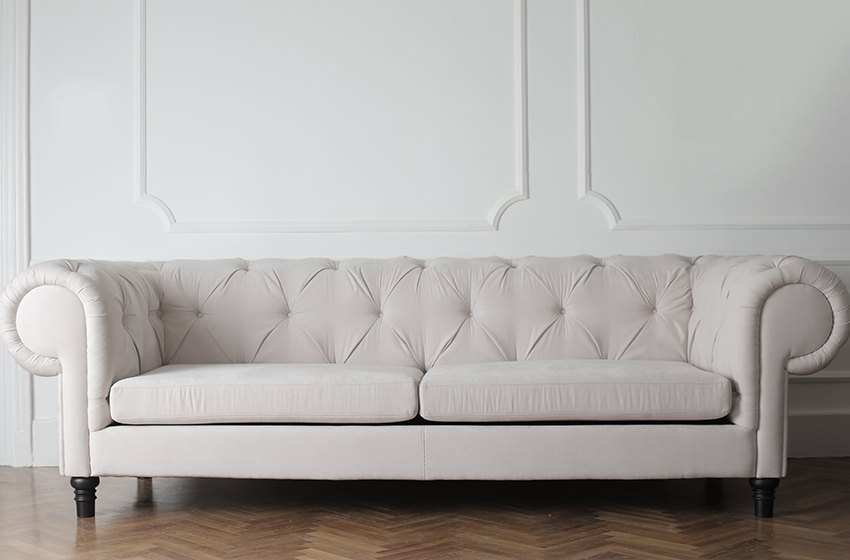
Fabric couches, sofas, and chairs are extremely popular for their comfort and durability, but even the best treated fabric will need an occasional clean to keep it in top condition. Most couches should be deep cleaned once or twice a year, but fabric furniture can sometimes need a little more TLC, including vacuuming once a month and treating spills and stains as soon as they happen. Whether you're overdue a routine clean or need some help preventing an accidental spill from becoming a permanent mark, our Pros know how to clean fabric couches and get them looking like new.
How to clean a fabric couch
The first thing you should check is the manufacturer's instructions. Many fabric couches have been pre-treated to prevent stains, and some cleaning solutions may reduce the effectiveness of the treatment or even invalidate the couch's warranty.
Many upholstered sofas have cleaning guidance on the label. Here are some of the most common cleaning codes and what they mean. You'll usually find the label for your couch attached underneath the cushions.
| Fabric Upholstery Cleaning Codes | |
| W | Use a water-based cleaner on this fabric |
| S | Use a solvent-based cleaner (dry clean only) |
| W/S | Can use water-based or solvent-based cleaners |
| X | Do not use water or solvent-based cleaners, vacuum or brush clean only |
Before cleaning your sofa, always spot check an inconspicuous area first. This will ensure you don't damage the finish of the fabric. Also check that the color won't run by scrubbing a small area with a white cloth and your cleaner of choice. If color comes off on the cloth, don't use that cleaning solution on the whole couch.
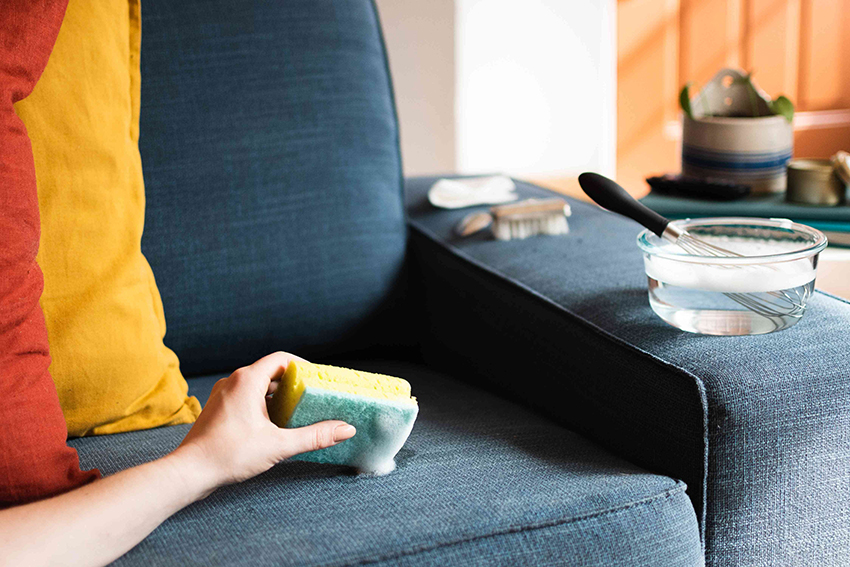
How to clean upholstery without a machine
Steam cleaning is a great way of removing dirt from a fabric sofa and giving it a new lease on life, but it isn't the only solution. You can easily clean a couch with a brush, vacuum cleaner, and a little elbow grease.
To clean a fabric sofa, follow these simple steps:
- Use a firm-bristled brush to remove any crumbs or loose dirt
- Vacuum the couch using the brush attachment
- Spot treat stubborn stains with a suitable cleaning solution
- Allow the couch to air dry
How to clean couch cushions
If your upholstered sofa has removable cushions, they can be cleaned separately. First, check the cleaning instructions on the label. Some fabric cushion covers can be machine washed. If this is true for your cushions, remove the covers and launder them.
To clean foam cushion pads, add a small amount of mild detergent designed for handwashing to a bath of warm water. Immerse the cushions and press them to get the water and soap into the foam. Rub away any stains, and then rinse them through with clean water to remove any soap residue. Allow them to air dry, turning occasionally to prevent water from being trapped inside or underneath the cushion.
If you can't launder your cushions, take them outside and give them a beating. This will remove any dust and dirt. Treat any stains with a suitable cleaning solution, or steam clean couches that have a W or WS code on the label. Couches marked X or S cannot be steam cleaned.
Now you know how to clean sofa upholstery at home!
Pro Tip: Learn how to clean your pillows as well to keep your whole house fresh and clean!
How do you deep clean a couch
Sometimes a routine cleaning isn't enough, and your couch might need to be deep cleaned. Kids, pets, and even clumsy adults can cause stains that need to be removed. Whether you're giving your family sofa some overdue TLC or cleaning and sanitizing a used couch, here's how to get it looking like new.
- Brush the couch to remove crumbs, dirt, and hair
- Use the brush attachment on a vacuum to clean more thoroughly
- Remove the cushions and clean them separately, if possible
- Sprinkle baking soda across the sofa and leave for 20-30 minutes
- Vacuum up the baking soda
- Spot treat stains
- Let the couch air dry
Pro Tip: Done cleaning your couch? Learn how to clean your mattress next!
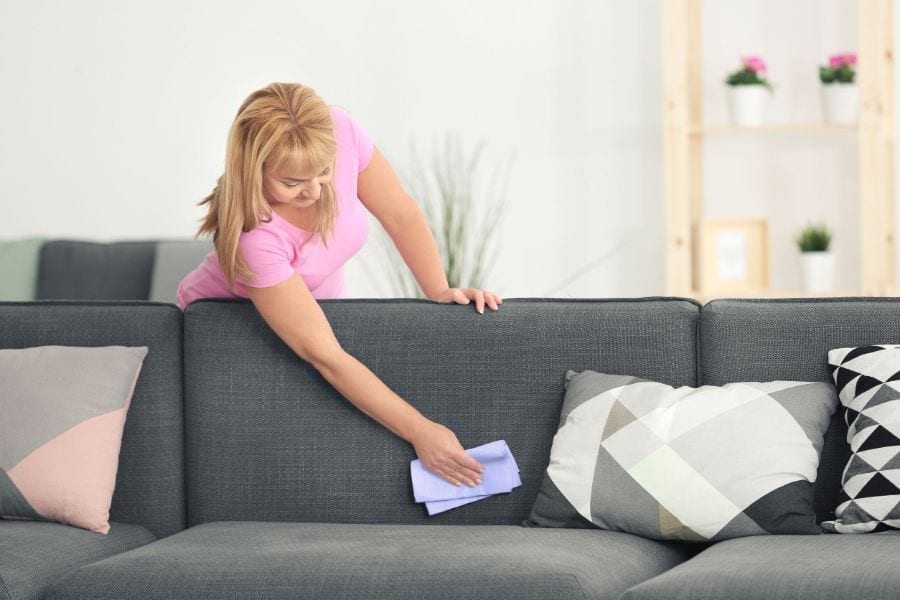
DIY fabric couch cleaner
There are many specialist fabric cleaners on the market, but you don't have to spend a fortune to spruce up your sofa. These DIY cleaners are suitable for use on many different fabrics. Just check the label and spot check an inconspicuous area first, and don't forget to check your couch's cleaning label to make sure you're using a suitable solution.
How to clean fabric sofa with vinegar
White vinegar is great for tackling stubborn stains, and is safe to use on most fabrics. That makes it ideal to clean a fabric sofa naturally. Make the following solution and use it to blot the stain — don't soak the sofa, and don't rub, because you risk spreading the stain.
- 1 cup warm water
- 1 cup white vinegar
- Optional: 1 teaspoon dish soap
How to clean an upholstered couch with detergent
Always use a detergent that's safe and appropriate for your fabric. You can purchase specialist upholstery detergents, or use a mild soap designed for hand washing. Alternatively, make the below solution and apply to the stain using a sponge. Don't get the stain too wet. When the stain has lifted, blot with clean water to remove the detergent and use paper towels to dry up excess moisture.
- 2 cups water
- 1 teaspoon detergent
How to clean fabric sofa without water
One of the best ways to remove dirt and stains is to use baking soda , especially on wet stains. Sprinkle over the area and leave for 20-30 minutes (or if the stain was still wet, until the baking soda has dried). Vacuum up the baking soda to remove.
Alternatively you can use dry cleaning cloths to remove dried-on stains. These cloths are pre-treated with a dry cleaning solution, so they're handy to have around. Follow the instructions on the label. Most dry cleaning cloths work by gently rubbing the stain to break it down. Use a hair dryer to heat the area if the cleaning solution needs to be heat activated.
How to shampoo a couch
The easiest way to shampoo a couch is to use a carpet cleaner or specialist couch cleaner. Begin by vacuuming the couch thoroughly to remove as much loose dirt as possible. Next fill the cleaner with water and detergent per the instructions. Try to avoid getting the couch too wet, as this can create problems with damp and mold if it doesn't dry out fast enough. Use the suction feature on the cleaner to remove as much water as possible. You can speed up drying by using old towels to blot up any excess water once you've finished cleaning. Let the sofa air dry before replacing the cushions. A fan can help speed this up by circulating air more rapidly.
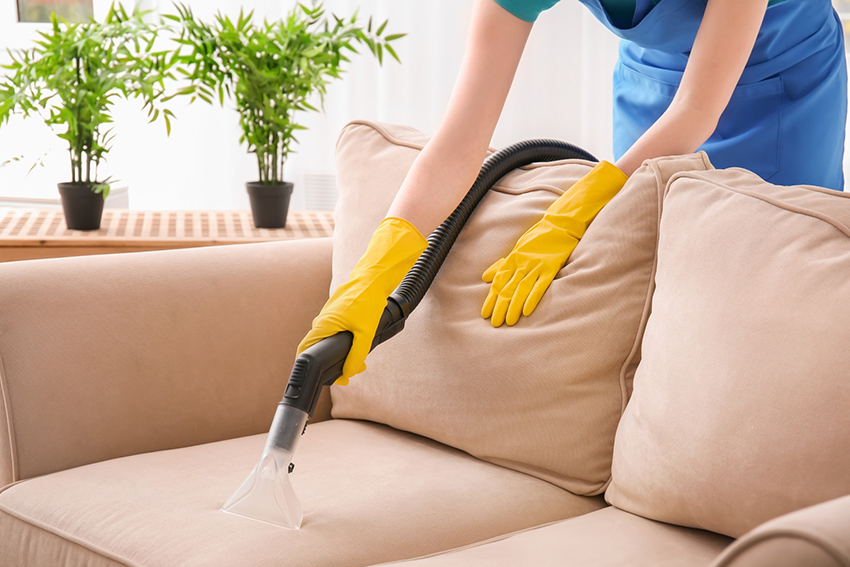
How to steam clean your couch
Another great way to clean a sofa is with a steam cleaner. These machines clean just with heat and water, so they are suitable for many fabrics. Choose a steam cleaner with an upholstery attachment to make the job easier. Follow the instructions on how to use the machine, and take care to stay out of the range of hot steam to avoid burns. Remember that heat rises, so don't lean over the applicator as you're using it. It may be easier to pull the couch away from walls into a clearer area so you can work around it easily.
To clean a fabric sofa with a steamer, start by removing cushions and steam cleaning them one side at a time. Allow each side to dry before turning them over and cleaning the other side. This prevents them from smelling damp. Use rapid strokes with the steamer attachment rather than blasting one area with steam continuously. This prevents the couch from becoming waterlogged.
Next, clean the frame of the sofa. Do this in small sections to ensure each area is thoroughly cleaned and nothing has been overlooked. Allow the couch to air dry before returning the cushions. Placing a fan nearby can speed up this process.
How to disinfect a sofa
Steam cleaning is an effective way of disinfecting a sofa, but there are other methods if you don't own one or want to hire a cleaner. Rubbing alcohol can kill a wide variety of germs and pathogens, making it a great choice.
- 2 cups rubbing alcohol
- 1 cup water
Combine the above in a spray bottle and lightly mist the couch. Take care not to get it too wet. Remove the cushions if possible to spray the frame and all sides of the cushions separately. Allow the couch and cushions to air dry.
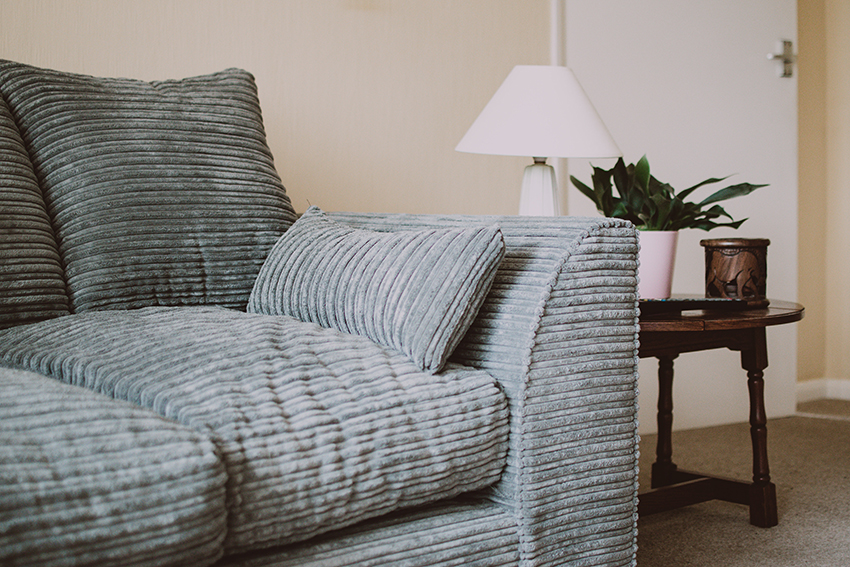
How to remove stains from a fabric sofa
Sofa stains happen all the time. Food, drink, dirt, and more can all cause stains. The cleaning methods listed above can all remove most food and dirt stains, but some types of stain need a little extra treatment to completely remove.
How to get water stains out of couch
If your couch fabric isn't water-resistant, it could end up with water marks if it suffers a spill. Combine half a cup of white vinegar with 2 cups of distilled water in a spray bottle and lightly mist the stain. Start at the outside of the stain and work inward. Blot the area thoroughly with a microfiber cloth to avoid it getting too wet, and to lift out the original marks. Use a fan or hair dryer to quickly dry out the area and prevent a new stain from forming.
How to get grease stains out of couch
The best way to remove grease stains is to use dish soap . It's designed to cut through grease quickly and easily. Simply add a teaspoon of detergent to 2 cups of water and blot the stain using a cloth or sponge. If you can't use a water-based cleaner on your fabric, use a dry cleaning cloth instead. These cloths are also treated to cut through grease in no time.
Pro Tip: Got paint in your fabric? Learn how to clean it now!
In conclusion
Getting a stain on your fabric couch doesn't have to be a disaster. Although upholstered furniture can seem tricky to clean, with the Pros in your corner it's easy! In addition, cleaning your couch as part of a routine spring clean can help extend its life and keep it looking like new for years to come.
How To Clean White Sofa With Baking Soda
Source: https://prohousekeepers.com/blog/how-to-clean-fabric-couches-and-sofas/
Posted by: rodriguezyoughter.blogspot.com

0 Response to "How To Clean White Sofa With Baking Soda"
Post a Comment